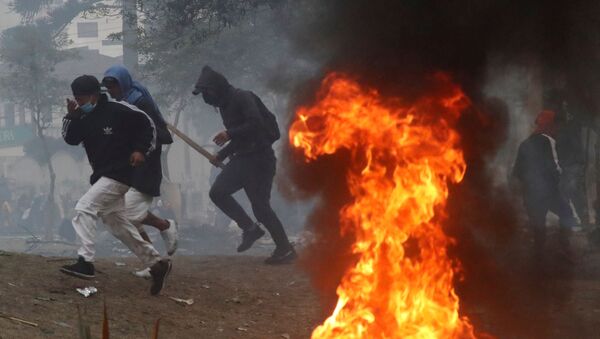According to protesters, Quito has become a battlefield – barricades, fires, crowds, tear gas, wounded, dead. The situation reached its peak on 12 October, when President Lenín Moreno announced that a curfew, effective from 9 October, would start at 3pm instead of 8pm.
By the time of the announcement, the main avenues leading to the National Assembly, the epicentre of the demonstrations, had gathered thousands of people, not only indigenous, but from many social sectors: young people, workers, students, women, the compassionate, angry, and those fed up with the government.
Raquel Tovar, a dental technician, explained why she is supporting her people and her home.
“It’s really painful to see how they are being killed, what they are doing with the natives; they have no compassion, no heart”, she said.
Like many protesters, she called for Lenín Moreno to back down with the economic measures, which have met broad popular rejection.
“It’s not fair that they kill men and women just because they are fighting for their rights (…) we are the people who fight; I am proud of my indigenous people because I feel indigenous too”, one lady said when she returned from a barricade.
Solidarity between the people of Quito and the indigenous movement has manifested itself in many ways. One of these is the permanent work of the volunteer medical brigades, as well as the constant coming and going of trucks with food and supplies, often homemade – like cloths soaked in lemon – to cope with tear gas.
The manifestations, which started in different neighbourhoods of the capital, gradually came to the central point of the confrontation. Columns with Ecuadorian flags and the same repeated slogan: “Down Moreno, down” (“fuera Moreno fuera”) could be seen marching in the streets.
The government has opted for several different types of tactics in this situation. They tried to generate fear with the announcement of the curfew, then with massive repression, and finally with the deployment of troops in the streets. The objective was to isolate and even to corner the indigenous movement in an empty city because of the prohibition against being on the street.
“We are people who are protesting for a common good, we don’t want to be poorer than we already are. The poor people who can buy bread [today] will no longer even be able to eat. This is who have come to the streets. If people don’t rise today, the government will continue filling their pockets with money”, a young protester said.
The political isolation of the indigenous movement was hindered by the "cacerolazo" – a rally followed by massive drumming on empty pots – that took place in Quito and other parts of the country at night. Thus, Lenín Moreno has not just been facing a protest from the indigenous people, but he has faced a crisis of legitimacy as a result of his decisions and his violence, which did not stop escalating over the ten days of protest.
In this context, the Ecuadorian Episcopal Conference and the United Nations announced that on 13 October there would be a first dialogue meeting between the indigenous movement and the government.
A dialogue with the government was achieved after a wave of cruelty that Ecuador had not seen for a long time. Quito, a city that has been transformed into a battlefield, could have a truce if an agreement is reached. Otherwise, the country will face a new wave of protests against the government, which is ready to tighten the pressure in order to preserve economic measures that have been rejected by most Ecuadorians.



